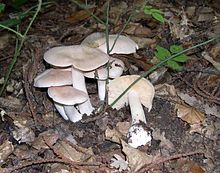
Summary
The Entolomataceae are a family of fungi in the order Agaricales. The family contains eight genera and 2250 species, the majority of which are in Entoloma.[1][2] Basidiocarps (fruit bodies) are typically agaricoid (mushrooms with gills), but a minority are cyphelloid. secotioid, or gasteroid. All produce pink basidiospores that are variously angular (polyhedral), ridged, or nodulose. Species are mostly saprotrophic, though a few are parasitic on other fungi. The family occurs worldwide.
| Entolomataceae | |
|---|---|

| |
| Entoloma sinuatum, Italy | |
| Scientific classification | |
| Domain: | Eukaryota |
| Kingdom: | Fungi |
| Division: | Basidiomycota |
| Class: | Agaricomycetes |
| Order: | Agaricales |
| Family: | Entolomataceae Kotl. & Pouzar (1972) |
| Type genus | |
| Entoloma | |
| Genera | |
|
Clitocella | |
| Synonyms | |
|
Clitopilaceae P.D. Orton (1960) nom. inval. | |
Taxonomy edit
The family Entolomataceae was first introduced in 1972 by the Czech mycologists František Kotlaba and Zdeněk Pouzar to replace the earlier name Rhodophyllaceae. The latter, introduced in 1951 by Rolf Singer, is illegitimate because it is based on the illegitimate genus Rhodophyllus which includes (and is therefore a superfluous synonym of) the earlier and legitimate name Entoloma.[3] The family is well defined by its distinctive spore morphology, formed by a unique type of spore-wall thickening called the "epicorium",[2] and by recent DNA studies.[4][2]
Genera edit
Many different internal classifications of the Entolomataceae have been proposed. In 1871, German mycologist Paul Kummer created the genera Eccilia, Leptonia, Nolanea, and Entoloma for species with angular spores, based on perceived differences in the morphology of fruit bodies. These genera were widely used throughout the twentieth century, but DNA studies have now shown them to be polyphyletic (artificial).
The current view is that Entolomataceae with angular spores should either all be classified in the genus Entoloma, which forms a large but monophyletic (natural) group,[2] or split between Entoloma and the smaller, basal group Entocybe.[5] Species with longitudinally ridged spores are classified in Clitopilus. Species with nodulose spores are classified in Rhodocybe or Rhodophana. Species with obscurely nodulose spores (appearing almost smooth under a microscope) are classified in Clitocella or Clitopilopsis.[6]
See list of Entolomataceae genera for a table of the main genera into which the family was formerly divided.
Distribution edit
The family has a cosmopolitan distribution and species are common in both temperate and tropical climates.[7]
-
-
Entocybe trachyospora
-
-
Rhodocybe fumanellii
-
Rhodophana nitellina
See also edit
References edit
- ^ "Catalogue of Life". Retrieved 2023-04-15.
- ^ a b c d D. Co-David; D. Langeveld; M.E. Noordeloos (Nov 2009). "Molecular phylogeny and spore evolution of Entolomataceae" (PDF). Persoonia. 23 (2). Leiden & Utrecht: National Herbarium of The Netherlands & the CBS Fungal Biodiversity Centre: 147–176. doi:10.3767/003158509x480944. PMC 2802732. PMID 20198166. Archived from the original (PDF) on 2011-07-27.. Figure 6 gives scanning electron micrographs allowing the shapes of Entoloma spores and Rhodocybe spores to be compared. See also this web page by M. Noordeloos Archived 2011-07-24 at the Wayback Machine which summarizes the information from the paper.
- ^ Kotlába, F.; Pouzar, Z., 1972, Ceská Mykologie 26(4): 218
- ^ Matheny PB, Curtis JM, Hofstetter V, Aime MC, Moncalvo JM, Ge ZW, Slot JC, Ammirati JF, Baroni TJ, Bougher NL, Hughes KW, Lodge DJ, Kerrigan RW, Seidl MT, Aanen DK, DeNitis M, Daniele GM, Desjardin DE, Kropp BR, Norvell LL, Parker A, Vellinga EC, Vilgalys R, Hibbett DS (2006). "Major clades of Agaricales: a multilocus phylogenetic overview" (PDF). Mycologia. 98 (6): 982–95. doi:10.3852/mycologia.98.6.982. PMID 17486974. Archived from the original (PDF) on 2016-03-03.
- ^ Baroni TJ, Hofstetter V, Largent DL, Vilgalys R (2011). "Entocybe is proposed as a new genus in the Entolomataceae (Agaricomycetes, Basidiomycota) based on morphological and molecular evidence" (PDF). North American Fungi. 6 (12): 1–19. doi:10.2509/naf2011.006.012. Archived (PDF) from the original on 2022-01-20. Retrieved 2022-06-03.
- ^ Kluting KL, Baroni TJ, Bergemann SE (2014). "Toward a stable classification of genera within the Entolomataceae: a phylogenetic re-evaluation of the Rhodocybe-Clitopilus clade". Mycologia. 106 (6): 1127–42. doi:10.3852/13-270. PMID 24987124. S2CID 40696041.
- ^ Cannon PF, Kirk PM. (2007). Fungal families of the world. CABI Publishing. 456 pp.
External links edit
- Machiel Noordeloos on Entoloma & Rhodocybe
- The Entolomataceae Family
- Family: Entolomataceae


